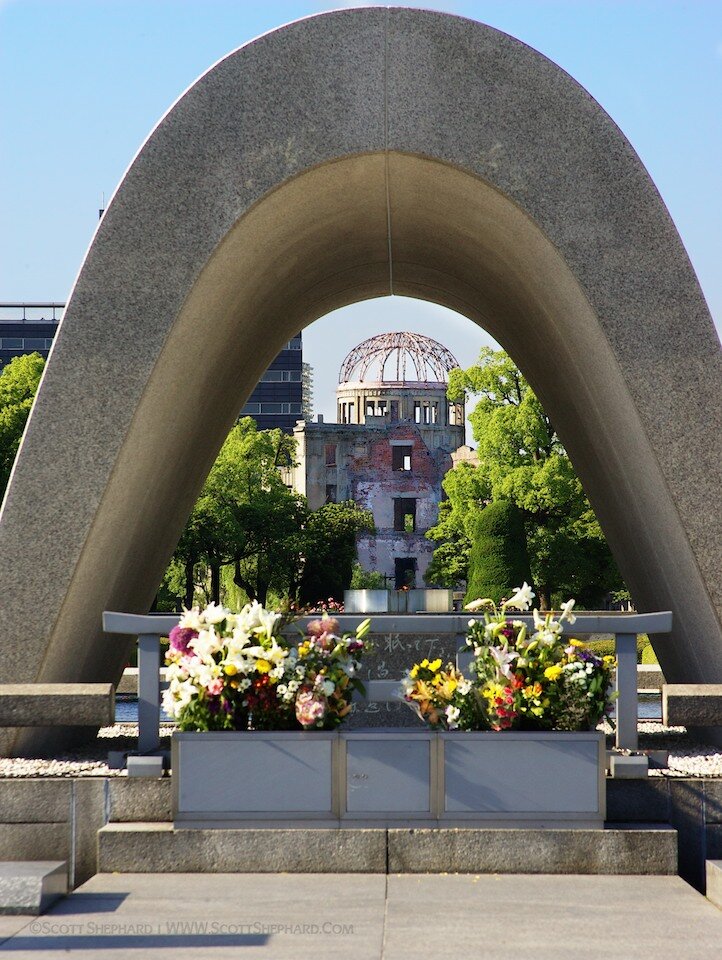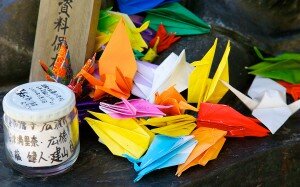 As I was thinking about the anniversary of the attack on the Twin Towers in New York on this day 11 years ago, I also thought about Hiroshima, which I visited in 2004.I avoid political commentary in this blog. So you should read nothing more into my post today beyond the fact that there have been many events in human history that have had profound impact on the architecture and psyche of a city but which also changed how everyone views the world. And I would say that 9/11 and the bombing of Hiroshima on August 6, 1945, are two such events.This photo, incidentally, shows the modern, arched Hiroshima Memorial (which shelters an eternal flame), framing a building which stood near ground zero. This building was left standing as the only remnant of a city center that was largely destroyed in the blink of an eye.
As I was thinking about the anniversary of the attack on the Twin Towers in New York on this day 11 years ago, I also thought about Hiroshima, which I visited in 2004.I avoid political commentary in this blog. So you should read nothing more into my post today beyond the fact that there have been many events in human history that have had profound impact on the architecture and psyche of a city but which also changed how everyone views the world. And I would say that 9/11 and the bombing of Hiroshima on August 6, 1945, are two such events.This photo, incidentally, shows the modern, arched Hiroshima Memorial (which shelters an eternal flame), framing a building which stood near ground zero. This building was left standing as the only remnant of a city center that was largely destroyed in the blink of an eye.
Hiroshima
Pondering the Imponderable
 This is a candid shot taken by an American photographer of a Japanese man studying a diorama of the destruction done by the atomic bomb to Hiroshima during WWII.Did I ever feel out of place while visiting Hiroshima? No. Did I feel any enmity from the Japanese I sometimes stood next to when I was at the Hiroshima Museum that day? No.I can't say how the Japanese man pictured here felt about United States' role in the destruction portrayed. But I do know that the Hiroshima Museum stands in part as a warning and as a lesson. The Museum and the Peace Center seem to say, "Here's what one relatively small bomb did. How can we prevent it from happening again?"I was uncertain about visiting Hiroshima. But I'm glad we did. . .
This is a candid shot taken by an American photographer of a Japanese man studying a diorama of the destruction done by the atomic bomb to Hiroshima during WWII.Did I ever feel out of place while visiting Hiroshima? No. Did I feel any enmity from the Japanese I sometimes stood next to when I was at the Hiroshima Museum that day? No.I can't say how the Japanese man pictured here felt about United States' role in the destruction portrayed. But I do know that the Hiroshima Museum stands in part as a warning and as a lesson. The Museum and the Peace Center seem to say, "Here's what one relatively small bomb did. How can we prevent it from happening again?"I was uncertain about visiting Hiroshima. But I'm glad we did. . .
8:15 am, August 6, 1945
 Today's photograph isn't all that remarkable. But the artifact in the photo is. This watch was being worn by a Hiroshima resident on the day the first atomic bomb was dropped. The watch survived the bomb blast but it quit working at the precise time the bomb detonated - 8:15 am. You can find this watch in the Hiroshima Peace Memorial Museum but I can't tell you what happened to the person wearing it.We visited Hiroshima in 2004 on our trip to Japan. Our son, Brian, took us there and I'm glad he did. The day we were there, we were sourrounded by Japanese citizens visiting this historic site and the memorial erected there. You would think that Americans might not be welcome at the bomb site and the museum. But that wasn't the case, largely because the memorial grounds house a peace center that aims to eliminate nuclear weapons. And I'm sure the Japanese are more than eager to welcome us to this cause.
Today's photograph isn't all that remarkable. But the artifact in the photo is. This watch was being worn by a Hiroshima resident on the day the first atomic bomb was dropped. The watch survived the bomb blast but it quit working at the precise time the bomb detonated - 8:15 am. You can find this watch in the Hiroshima Peace Memorial Museum but I can't tell you what happened to the person wearing it.We visited Hiroshima in 2004 on our trip to Japan. Our son, Brian, took us there and I'm glad he did. The day we were there, we were sourrounded by Japanese citizens visiting this historic site and the memorial erected there. You would think that Americans might not be welcome at the bomb site and the museum. But that wasn't the case, largely because the memorial grounds house a peace center that aims to eliminate nuclear weapons. And I'm sure the Japanese are more than eager to welcome us to this cause.
A Colorful Wish
 Ten years after the bombing of Hiroshima, a young girl named Sadako Sasaki died of leukemia as a result of radiation from the nuclear bomb that was dropped on her city. But before she died, she folded nearly 1000 origami paper cranes. Legend had it that if you folded 1000 paper cranes, you would be granted a wish. Her wish, of course, was to be healthy again so she could run and play with the other children.Sadly, she died. But her story became famous and today the origami crane is a symbol of international peace. This photo was taken at Hiroshima. But not too long ago I walked into a geography classroom in my school in Watertown, SD, and hanging from the ceiling was a multitude of colorful paper cranes.The Hirsoshima Peace Memorial wasn't on my list of things to see when we visited Japan a few years ago but our son Brian insisted that we go. I'm glad we did. Interestingly, I am moved more now when I look at the photos I took than I was when I was taking them. But at that time, I didn't know the story of Sadako Sasaki.Here's a view of of the monument that houses the eternal flame, with the famous Genbaku Dome in the background. Click here for a bird's eye view.
Ten years after the bombing of Hiroshima, a young girl named Sadako Sasaki died of leukemia as a result of radiation from the nuclear bomb that was dropped on her city. But before she died, she folded nearly 1000 origami paper cranes. Legend had it that if you folded 1000 paper cranes, you would be granted a wish. Her wish, of course, was to be healthy again so she could run and play with the other children.Sadly, she died. But her story became famous and today the origami crane is a symbol of international peace. This photo was taken at Hiroshima. But not too long ago I walked into a geography classroom in my school in Watertown, SD, and hanging from the ceiling was a multitude of colorful paper cranes.The Hirsoshima Peace Memorial wasn't on my list of things to see when we visited Japan a few years ago but our son Brian insisted that we go. I'm glad we did. Interestingly, I am moved more now when I look at the photos I took than I was when I was taking them. But at that time, I didn't know the story of Sadako Sasaki.Here's a view of of the monument that houses the eternal flame, with the famous Genbaku Dome in the background. Click here for a bird's eye view.
